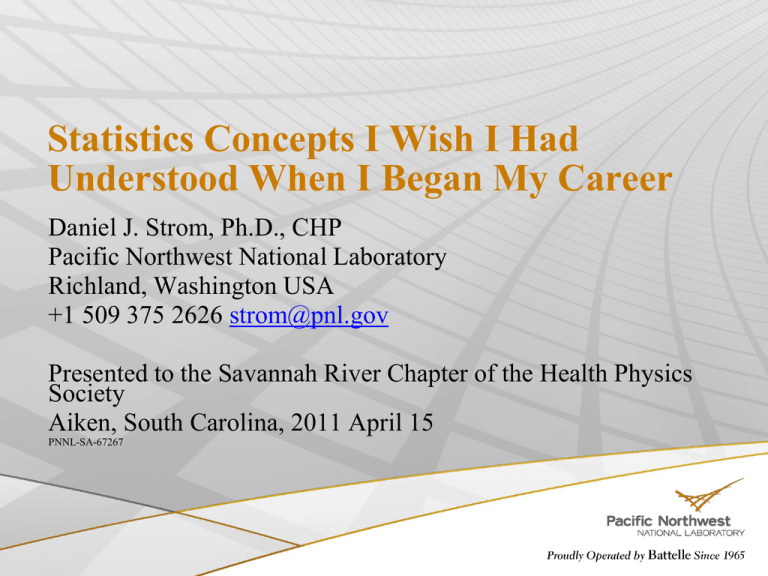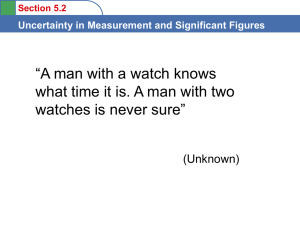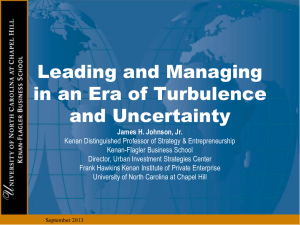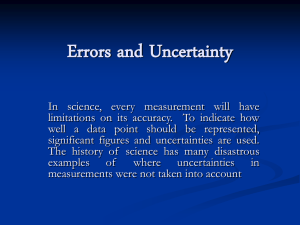
Statistics Concepts I Wish I Had
Understood When I Began My Career
Daniel J. Strom, Ph.D., CHP
Pacific Northwest National Laboratory
Richland, Washington USA
+1 509 375 2626 strom@pnl.gov
Presented to the Savannah River Chapter of the Health Physics
Society
Aiken, South Carolina, 2011 April 15
PNNL-SA-67267
Outline
• Needs of occupational and environmental protection
• Definitions of basic concepts
• Measurement
• Modeling
• Inference
•
•
•
•
•
Variability
Uncertainty
Bias
Error
Blunder
• Bayesian and classical statistics
• Shared and unshared uncertainties
• Berkson (grouping) and classical (measurement)
uncertainties
• Autocorrelation
• Decision threshold and minimum detectable amount
• Censoring
2
Occupational and Environmental Protection
• Requires rigorous understanding of the concepts of
uncertainty, variability, bias, error, and blunder, which are
crucial for understanding and correct inference
• Deals with uncertain, low-level measurements, some of
which may be zero or negative
• Requires that decisions be made based on measurements
• Consequences of wrong decisions may result in
–
–
–
–
Needlessly frightened workers and public
Disrupted work
Wasted money
Failure to protect health and the environment
3
2008 ISO Guide to the Expression of Uncertainty in
Measurement (GUM)
• Extensive, well-thought-out framework for dealing
with uncertainty in measurement
– Clearly-defined concepts and terms
– Practical approach
• Doesn’t cover
– the use of measurements in models that have uncertain
• assumptions
• parameters
• form
– representativeness (e.g., of a breathing-zone air sample)
– inference from measurements (e.g., dose-response
relationship)
ISO. 2008. Uncertainty of Measurement - Part 3: Guide to the expression of
uncertainty in measurement (GUM: 1995). Guide 98-3 (2008), International
Organization for Standardization, Geneva, Switzerland.
4
2008 ISO GUM General Metrological Terms - 1
ISO-GUM Term
(measurable) quantity
Meaning
attribute of a phenomenon, body, or substance that may be
distinguished qualitatively and determined quantitatively
value (of a quantity)
magnitude of a particular quantity generally expressed as a unit of
measurement multiplied by a number
value of a measurand
particular quantity subject to measurement. [the unknown value
of a physical quantity representing the “true state of Nature” This
is sometimes called the “true value” or the “actual value”]
value attributed to a particular quantity and accepted, sometimes
by convention, as having an uncertainty appropriate for a given
purpose
set of operations having the object of determining a value of a
quantity
conventional true value
(of a quantity)
measurement
5
2008 ISO GUM General Metrological Terms - 3
ISO-GUM Term
Meaning
result of a measurement value attributed to a measurand, obtained by measurement
uncorrected result
corrected result
accuracy of
measurement
repeatability (of results
of measurements)
reproducibility (of
results of
measurements)
result of a measurement before correction for systematic error
(i.e., bias)
result of a measurement after correction for systematic error (i.e.,
bias)
closeness of the agreement between the result of a measurement
and a true value of the measurand
closeness of the agreement between the results of successive
measurements of the same measurand carried out under the same
conditions of measurement
closeness of agreement between the results of measurements of
the same measurand carried out under changed conditions of
measurement
6
2008 ISO GUM General Metrological Terms - 5
ISO-GUM Term
uncertainty (of
measurement)
error (of measurement)
relative error
Meaning
parameter, associated with the result of a measurement, that
characterizes the dispersion of the values that could reasonably be
attributed to the measurand. It is a bound for the likely size of the
measurement error.
result of a measurement minus a true value of the measurand (i.e.,
the [unknowable] difference between a measured result the actual
value of the measurand.) “Error is an idealized concept and errors
cannot be known exactly” (Note 3.2.1)
error of measurement divided by a true value of the measurand
correction
value added algebraically to the uncorrected result of a
measurement to compensate for systematic error
correction factor
Numerical factor by which the uncorrected result of a
measurement is multiplied to compensate for systematic error
7
Types of Uncertainty in Models (Wikipedia)
1. Uncertainty due to variability of input and / or model
parameters when the characterization of the variability
is available (e.g., with probability density functions,
pdf)
2. Uncertainty due to variability of input and/or model
parameters when the corresponding variability
characterization is not available
3. Uncertainty due to an unknown process or mechanism
• Type 1 uncertainty, which depends on chance, may be
referred to as aleatory or statistical uncertainty
• Type 2 and 3 are referred to as epistemic or systematic
uncertainties
http://en.wikipedia.org/wiki/Uncertainty_quantification
8
2008 ISO GUM Basic Statistical Terms & Concepts - 5
ISO-GUM Term
arithmetic mean;
average
Non- ISO-GUM
Term
geometric mean
Meaning
the sum of values divided by the number of values:
1
x xi
n
Meaning
the nth root of the product of n values:
1
x gm exp ln xi
n
median
For 2 values, xgm x1x2
the value in the middle of a distribution, such that there is
an equal number of values above and below the median.
Also known as the 50th percentile, x50
mode
the most frequently occurring value
9
Non-ISO GUM
Basic Statistical Terms & Concepts
Non- ISO-GUM Term
harmonic mean
Meaning
the inverse of the average of the inverses:
1
n
xhm
1
1
1
x x
n
i
i
• Example in health physics: Suppose dose to biota is proportional
to concentration in river water. For a given release rate (Bq/year),
concentration in water is inversely proportional to flow rate in the
river. Suppose you have river flow rate data for several years. You
will correctly predict the average dose if you use the harmonic
mean of the river flow rate data.
• Another example in health physics: If you want the risk per
sievert, you need the harmonic mean of the sieverts!
10
2008 ISO GUM Additional Terms & Concepts - 1
ISO-GUM Term
blunder
“Type A” uncertainty
evaluation
Meaning
“Blunders in recording or analyzing data can introduce a
significant unknown error in the result of a measurement. Large
blunders can usually be identified by a proper review of all the
data; small ones could be masked by, or even appear as, random
variations. Measures of uncertainty are not intended to account
for such mistakes.” (3.4.7) Other terms include mistake and
spurious error. [In software, blunders may be caused by “bugs.”]
uncertainty that is evaluated by the statistical analysis of series of
observations
“Type B” uncertainty
evaluation
uncertainty that is evaluated by means other than the statistical
analysis of a series of observations
11
Type A and Type B Uncertainty
• Uncertainty that is evaluated by the statistical analysis
of series of observations is called a “Type A”
uncertainty evaluation.
• Uncertainty that is evaluated by means other than the
statistical analysis of a series of observations is called
a “Type B” uncertainty evaluation.
• Note that using N as an estimate of the standard
deviation of N counts is a Type B uncertainty
evaluation!
12
Uncertainty and Variability
• Uncertainty
– stems from lack of knowledge, so it can be
characterized and managed but not eliminated
– can be reduced by the use of more or better data
• Variability
– is an inherent characteristic of a population,
inasmuch as people vary substantially in their
exposures and their susceptibility to potentially
harmful effects of the exposures
– cannot be reduced, but it can be better characterized
with improved information
-- National Research Council. 2008. Science and Decisions: Advancing Risk
Assessment. http://www.nap.edu/catalog.php?record_id=12209, National
Academies Press, Washington, DC
13
An Example of Variability in a Population
14
Distribution of Annual Effective Dose in the US
Population Due to Ubiquitous Background Radiation
Average = 3.11 mSv y-1
2.5 million > 20 mSv y-1
Terms: Error, Uncertainty, Variability
• “The difference between error and uncertainty should
always be borne in mind.”
• “For example, the result of a measurement after
correction can unknowably be very close to the unknown
value of the measurand, and thus have negligible error,
even though it may have a large uncertainty.”
• If you accept the ISO definitions of error and uncertainty
– there are no such things as “error bars” on a graph!
– such bars are “uncertainty bars”
• Variability is the range of values for different individuals
in a population
– e.g., height, weight, metabolism
16
Graphical Illustration of Value, Error, and Uncertainty
17
Graphical Illustration of Value, Error, and Uncertainty
18
Graphical
Illustration
of Value,
Error, and
Uncertainty
19
Random and Systematic “Errors”
ISO-GUM Term
random error
systematic error
Meaning
result of a measurement minus the mean that would result from an
infinite number of measurements of the measurand carried out
under repeatability conditions
mean that would result from an infinite number of measurements
of the same measurand carried out under repeatability conditions
minus a true value of the measurand
• Uncertainty is our estimate of how large the error may
be
• We do not know how large the error actually is
20
Random and Systematic Uncertainty versus
Type A and Type B Uncertainty Evaluation
• GUM: There is not always a simple correspondence
between the classification of uncertainty components into
categories A and B and the commonly used classification
of uncertainty components as “random” and
“systematic.”
• The nature of an uncertainty component is conditioned
by the use made of the corresponding quantity, that is, on
how that quantity appears in the mathematical model that
describes the measurement process.
• When the corresponding quantity is used in a different
way, a “random” component may become a “systematic”
component and vice versa.
21
Random and Systematic Uncertainty
• Thus the terms “random uncertainty” and “systematic
uncertainty” can be misleading when generally applied.
• An alternative nomenclature that might be used is
“component of uncertainty arising from a random
effect,” “component of uncertainty arising from a
systematic effect,” where a random effect is one that
gives rise to a possible random error in the current
measurement process and a systematic effect is one that
gives rise to a possible systematic error in the current
measurement process. In principle, an uncertainty
component arising from a systematic effect may in some
cases be evaluated by method A while in other cases by
method B, as may be an uncertainty component arising
from a random effect.
22
Type A Uncertainty Evaluation
• represented by a statistically estimated standard
deviation
2
si
si
• associated number of degrees of freedom = vi.
• the standard uncertainty is ui = si.
23
Type B Uncertainty Evaluation
• represented by a quantity uj
• u j corresponding standard deviation
uj
u 2j ;
u 2j corresponding variance obtained from an
assumed probability distribution based on all the
available information
• Since the quantity uj2 is treated like a variance and uj
like a standard deviation, for such a component the
standard uncertainty is simply uj.
24
2008 ISO GUM Additional Terms & Concepts - 2
ISO-GUM Term
combined standard
uncertainty
Meaning
standard uncertainty of the result of a measurement when that
result is obtained from the values of a number of other quantities,
equal to the positive square root of a sum of terms, the terms
being the variances of covariances of these other quantities
weighted according to how the measurement result varies with
changes in these quantities.
25
The First Step
• Must know what y depends on, and how:
y f ( x1 , x2 , ..., xn )
26
Uncertainty Propagation Formula
• Combined standard uncertainty
2
N 1 N
f
f f
2
2
u ( xi ) 2
uc ( y )
u ( xi , x j )
i 1 xi
i 1 j i 1 xi x j
Sum of variance terms and covariance terms
• Derived from first-order Taylor series expansion
• Covariances usually unknown and ignored
• Not accurate for large uncertainties (e.g., broad
lognormal distributions)
N
27
Uncertainty Propagation Formula – 2
• Formulation using correlation coefficient r(xi,xj)
f
i 1 xi
N
uc2 ( y )
2
2
2
u ( xi )
N 1 N
i 1 j i 1
f f
r ( xi , x j ) s( xi ) s( x j )
xi x j
• See Rolf Michel’s wipe test example:
http://www.kernchemie.unimainz.de/downloads/saagas21/michel_2.pdf
28
Numerical Methods
• Monte Carlo simulations, with covariances, may be
needed to explore uncertainty
• Crystal Ball™ does this easily
29
Measuring, Modeling, and Inference
• Measuring is adequately addressed by many
organizations
• Modeling is required to infer quantities of interest from
measurements
• Examples of models
–
–
–
–
–
dosimetric phantoms
biokinetic models
respiratory tract, GI tract, and wound models
environmental transport and fate models
dose-response models
• Inference is the process of getting to what we want to
know from what we have measured or observed
30
When Does Variability Become Uncertainty?
• The population characteristic variability becomes
uncertainty when a prediction is made for an individual,
based on knowledge of that population
• Example: How tall is a human being you haven’t met?
– If you have no other information, this has a range from 30 cm
to 240 cm
– If you have age, weight, sex, race, nationality, etc., you can
narrow it down
31
Classical and Bayesian Statistics
• Bayesian statistical inference has replaced classical
inference in more and more areas of interest to health
physicists, such as determining whether activity is
present in a sample, what a detection system can be
relied on to detect, and what can be inferred about intake
and committed dose from bioassay data.
32
Example: The Two Counting Problems
• Radioactive decay is a Bernoulli process described by
a binomial or Poisson distribution
– A Bernoulli process is one concerned with the count of the
total number of independent events, each with the same
probability, occurring in a specified number of trials
• The “forward problem”
– from properties of the process, we predict the distribution of
counting results (mean, standard deviation (SD))
– measurand distribution of possible observations
• The “reverse problem”
– measure a counting result
– from the counting result, we infer the parameters of the
underlying binomial or Poisson distribution (mean, SD)
see, e.g., Rainwater and Wu (1947)
– this is the problem we’re really interested in!
33
Two Kinds of Statistics
• Classical statistics
– does the forward problem well
– does not do the reverse problem
• Bayesian statistics does the reverse problem using
– a prior probability distribution
– the observed results
– a likelihood function (a classical expression of the forward
problem)
34
Bayes’s Rule (Simple form)
• Names:
P( A | B) P( B)
P( B | A)
P( A)
Likelihood Prior
Posterior
Normalizing Factor
• Example
Probability that thetruecount rateis B
given thatwe' ve observeda count rateof A
(Likelihood of A given B) (Priorprobability of A)
Normalizing Factor
35
Philosophical Statement of Bayes’s Rule
P(measurand| evidence)
L(evidence| measurand) P(measurand)
normalizing factor
• The measurand or “state of nature” (e.g., count rate from
analyte) is what we want to know
• The “evidence” is what we have observed
• The likelihood of the “evidence” given the measurand is
what we know about the way nature works
• The probability of the state of nature is what we believed
before we obtained the evidence
38
Bayes’s Rule: Continuous Form
• P’s are probability densities
L( N | ) P ( )
P( | N )
L( N | ) P( ) d
0
Likelihood Prior
Posterior
Normalizing Factor
• We want to determine the posterior probability
density
39
Posterior Probability Densities for
(conditional on observed values)
1.0
Observed: Probability
Probablilty Density (Normalized)
0.9
0:
e-
1:
e-
2:
(1/2) e-
0.6
3:
(1/6) e-
0.5
4:
(1/24) e-
0.8
0.7
0.4
0.3
0.2
0.1
0.0
0
1
2
3
4
5
6
Poisson mean,
40
7
8
9
10
Implementation of Bayesian Statistical Methods
in Health Physics
• LANL has routinely used Markov Chain Monte Carlo
methods for over a decade
– Pioneered by Guthrie Miller
– See work by Miller and others in RPD and HP
• DOE uses the IMBA software package that incorporates
the WeLMoS Bayesian method
– See work by Matthew Puncher and Alan Birchall in RPD
• NCRP will likely endorse some Bayesian methods
• The ISO 11929-series standards on decision
thresholds and detection limits are all Bayesian
• Semkow (2006) has explicitly solved the counting
statistics problem for a variety of Bayesian priors
Semkow TM. 2006. "Bayesian Inference from the Binomial and Poisson Processes for Multiple Sampling." Chapter 24 in
Applied Modeling and Computations in Nuclear Science, eds. TM Semkow, S Pommé, SM Jerome, and DJ Strom,
pp. 335-356. American Chemical Society, Washington, DC.
41
ISO 11929:2010(E)
“Determination of the characteristic limits (decision
threshold, detection limit and limits of the confidence
interval) for measurements of ionizing radiation —
Fundamentals and application”
• Covers
– Simple counting
– Spectroscopic measurements
– The influence of sample treatment (e.g., radiochemistry)
42
MARLAP
“Multi-Agency Radiological Laboratory Analytical
Protocols Manual. EPA 402-B-04-001A, B, and C”
• http://www.epa.gov/radiation/marlap/manual.htm
• Chapters 19 and 20 cover many statistical concepts
related to radioactivity measurements
43
The Hardest Concepts I’ve Ever Tried
to Communicate to a Health Physicist
What’s the smallest count rate that is almost
certainly not background?
What’s the smallest real activity that I’m almost
certain to detect if I use the decision threshold as my
criterion?
44
45
Alan Dunn in The New Yorker (1972)
Outline
• The problem: Hearing a whisper in a tempest
• Nightmare terminology
• Disaggregating two related concepts in counting
statistics:
– “Critical Level” and “Detection Level” (Currie 1968)
– “Decision Level” and “Minimum Detectable Amount” (ANSIHPS)
– “Decision Threshold” and “Detection Limit” (ISO, MARLAP)
• What I wish I’d been taught
– A required concept: the measurand
– Population parameters and sample parameters
• Greek and Roman
• easurad
• 7 Questions
46
The Problem: Hearing a Whisper in a Tempest
• Picking the signal out of the noise: Is anything there?
• From the earliest days of radiation protection growing out of the
Manhattan Project, health physicists came to realize that it was
important to detect
– tiny activities of alpha-emitters in the presence of background radiation
– small changes in the optical density of radiation sensitive film
• Vocabulary to describe their problems didn’t exist
• Vocabulary and concepts of measurement decisions and
capabilities began to be developed in the 1960s
• Vocabulary
– non-descriptive
– confusing
– even seriously misleading
• Worse, most HPs are fairly sure they know what they mean by the
words they use, and too often they are wrong
47
Terminology Is a Mess! and This Is Just in English!
“DL”
Name
decision level
“MDA”
minimum detectable amount
What?
the lowest useable action level
NOT an action level!
Use:
compare measurements to DL
When?
a posteriori: after the
measurement is made
Defined in
HPS/ANSI N13.30
Use in planning, advertising or in a statement of
work for a contractor: “How much will you charge
to provide counting services with this MDA?”
a priori: before the measurement is made
(but it does “vary with the nature of the sample” –
NUREG-4007)
HPS/ANSI N13.30
Currie’s Name
critical level, LC
detection level, LD
Ill-defined Names
Turner’s name
lower limit of detection, LLD; also, un-fortunately,
“lower level discriminator,” detection limit, limit of
detection (“LOD”)
“minimum detectable true activity”
ISO 11929 name
“minimum significant measured
activity”
“decision threshold”
Spanish name
umbral de decision
limite de deteccion
MARLAP name
“critical value of []”
Strom’s name
“false alarm level”
“minimum detectable amount” or “minimum
detectable concentration”
“advertising level”
“expected detection capability”
Strom
“detection limit”
What I Wish We’d All Been Taught
49
The Measurand: The True Value of the Quantity
One Wishes to Measure
• The goal: measurement of a well-defined physical
quantity that can be characterized by an essentially
unique value
• ISO calls the ‘true state of nature’ the measurand
– 1980
– International Organization for Standardization (ISO). 2008.
Uncertainty of Measurement - Part 3: Guide to the expression
of uncertainty in measurement (GUM: 1995). Guide 98-3
(2008), Geneva.
50
Population Parameters:
Characteristics of the Measurand
• By convention, Greek letters denote population
parameters
• These reflect the measurand, the “true state of Nature”
whose value we are trying to infer from measurements
• Measurands:
– r : long-term count rates of sample and blank (per s)
– A: the activity of the sample (Bq)
• Actually, the difference in activity between sample
and blank
• Detection Level, Minimum Detectable Amount, Detection
Limit: these identical quantities are population statistics
• If only they’d written LD, MDA, DL
51
Sample Parameters:
What We Can Observe
• By convention, Roman letters denote observables, the
sample parameters
• Examples of sample parameters
– R: observed count rates of blank and sample (per s)
• The Critical Level LC, the Decision Level DL, and the
Decision Threshold are all sample statistics
52
The hardest concepts to communicate to health
physicists and their managers
1. For a given measurement system, how big does the signal need to
be for one to decide that it is not just noise?
2. How does one decide whether a measurement result represents a
positive measurand and not a false alarm?
3. What do negative counting results mean?
4. What’s the smallest measurement result one should record as
greater than zero?
5. What is the largest measurand that one can fail to detect 5% of the
time?
6. What is the smallest measurand that one will almost always
detect?
7. What value of the measurand can one detect with 10%
uncertainty?
53
Decision Threshold
54
Alan Dunn in The New Yorker (1972)
No Handle to Pull!
MDA
(da)
Irrelevant After Measurement
Unlikely to be noise:
Pull handle!
DL
Decision Threshold
Too likely to be noise:
Don’t pull handle.
noise
55
Conclusions
One frequently detects results that are less than the MDA
but greater than the DT/DL
Never compare a result with an MDA; always compare it
with the DT/DL
Use the ISO or MARLAP DT/DL and MDA if you want the
right answer; use traditional DT/DL and MDA only if
required by a regulator or on an exam
Strom and MacLellan. 2001. "Evaluation of Eight Decision Rules for LowLevel Radioactivity Counting." Health Phys 81(1):27-34
56
<DL
<MDA
Always compare a result with DL
Never compare a result with MDA!
57
<DL
<MDA
Always compare a result with DL
Never compare a result with MDA!
58
“Censoring” of Data
• Censoring data means changing measured results from
numbers to some other form that cannot be added or
averaged or analyzed numerically
• Examples of data censoring
– Left-censoring
• changing results that are less than some value to zero
• changing results that are less than some value to “less than” some value
– Right-censoring
• changing values from the measured result to “greater than” some value
– Rounding
59
Why should censoring of data be avoided?
• Censoring means changing the numbers
• In a sense, it is dishonest
• If results are ever
– summed,
– averaged, or
– used for some other aggregate analysis such as fitting a
distribution,
censoring makes this
– difficult,
– impossible, or
– simply biased.
60
Censoring Examples
• Five results for discharge from a pipe taken over 1 year
– uncensored results: 2, 1, 0, 1, and 2
– sum = 0 (total discharge for the year is 0)
– average = 0 (average discharge for the year is 0)
• Example 1: Set negative values to zero
– censored results: 0, 0, 0, 1, and 2
– sum = 3 (i.e., total discharge for the year is 3; this is not true)
– average = 0.6 (i.e., average discharge for the year is 0.6; false)
• Example 2: Suppose LC = 2. Set all values < 2 to “<”
– censored results: <, <, <, <, and 2
– sum = ? (total discharge for the year cannot be determined)
– average = ? (average discharge for the year cannot be
determined)
61
But Negative Activity Is Meaningless…
• No, it’s not meaningless
• Just like money, subtracting a big number from a small
number gives a negative value
–
–
–
–
You have 100€, you charge 200€, you owe 100€
100€ 200€ = 100€ (your net value)
this doesn’t mean you can find a bank note for 100€
stocks go up and down; the end of the year value includes all
changes, positive and negative
• Negative activity only means that random statistical
fluctuations resulted in a negative number
• If negative, zero, or less-than values are suppressed, the
sum is biased.
62
More Reasons Not to Censor
• Upper confidence limits of negative, zero, or less-than
values
– may be small positive numbers
– needed for some applications (e.g., probability of causation)
• Censoring is prohibited by many standards and regulations
– ANSI N13.30-1996: “Results obtained by the service laboratory
shall be reported to the customer and shall include the following
items …quantification using appropriate blank values of
radionuclides whether positive, negative, or zero”
– Many U.S. Department of Energy regulations require reporting
raw data, calculated results (positive, negative, or zero), and total
propagated uncertainties
– Decision on actions can be made with uncensored data
63
Rounding Is Censoring
• Rounding a number is
– changing its value
– biasing the value
– censoring
• Rounding often “justified” by claiming uncertainty
– Uncertainty does not justify changing the answer
– Explicitly state the uncertainty
• Beware of converting units of a rounded number and then
rounding again!
• Intermediate results and laboratory records should never
be rounded
• The only time to round is in presentations or
communications
64
Censoring
Report and Record All Measurements with No
Censoring and Minimal Rounding
65
“Nondetects” Is a Must-Read
• Classical (frequentist), not Bayesian
• Dennis Helsel (USGS) has studied the
problem for decades
• Points out the shortcomings of
common methods such as censoring
by imputing
– 0
– DL/2
– DL
Helsel DR. 2005. Nondetects and Data Analysis. Statistics for Censored
Environmental Data. John Wiley & Sons,66Hoboken, New Jersey.
What if...?
• How would occupational and environmental protection
change if exposure and dose limits applied to the upper
95% confidence limit of a measured or modeled value?
• Employers would have 2 incentives:
– Reduce doses so that the “upper 95” was below the limit
– Reduce uncertainty in assessment of occupational exposures so
that small doses with formerly large uncertainties would have
an “upper 95” below the limit
• Either effect would be good for the worker!
– The worker would be assured of being protected regardless of
the employer’s ability to monitor dose
– Impact would be large for protection of some workers
• Regulation of chemical exposures on the “upper 95”
suggested by Leidel and Busch in 1977...
67
Summary 1
• There have been many new developments in the science
of uncertainty
• Meanings of common words have crystallized
• Error is the unknown and unknowable difference
between the measurand and our value
• Uncertainty is our estimate of how large the error may
be
• Variability is a natural characteristic of a population
• Metrology terminology is mature, but modeling
continues to evolve
• An incorrect estimate of a parameter caused by incorrect
treatment of uncertainty is called a biased estimate
• A blunder is a mistake
68
Summary 2
• Bayesian statistical inference provides a formal way of
using all available knowledge to produce a probability
distribution of unknown parameters
• Uncertainty analysis for populations must account for
– Berkson (grouping) and classical (measurement) errors
– Shared and unshared errors
– Autocorrelations over time within individuals
• Multiple realizations of possibly true doses that correctly
treat the effects of various uncertainties on inferences of
dose-response relationships are necessary for unbiased
radiation risk estimates
• Sophisticated treatment of uncertainty is becoming a
requirement in more areas of health physics, including
measuring, modeling, and inference
69
<DL
<MDA
Always compare a result with DL
Never compare a result with MDA!
70
Censoring
Report and Record All Measurements with No
Censoring and Minimal Rounding
71
Questions?
• Please e-mail Strom@pnl.gov for unanswered questions,
references or other information regarding this talk
72
Outline
• Needs of occupational and environmental protection
• Definitions of basic concepts
• Measurement
• Modeling
• Inference
•
•
•
•
•
Variability
Uncertainty
Bias
Error
Blunder
• Bayesian and classical statistics
• Shared and unshared uncertainties
• Berkson (grouping) and classical (measurement)
uncertainties
• Autocorrelation
• Recent developments
73









